Top Business Automation Solutions to Boost Efficiency
Level Up Your Workflow With Business Automation
Juggling multiple tasks, meeting deadlines, and staying ahead of the curve can be a challenge. For social media influencers, small business owners, content creators, freelancers, and marketing professionals, time is a precious commodity. Remember manually scheduling each social media post, meticulously tracking invoices, or spending hours answering similar customer questions?
Business automation has changed how we work, transforming tedious, repetitive tasks into efficient processes. From basic scripting and macro commands to today's AI-powered platforms, automation has consistently improved productivity.
What makes a business automation solution truly effective? It's more than automating a single task. It's about intelligently integrating various processes, minimizing human error, and freeing up your time and energy to focus on what matters most – growing your business and pursuing your passions. Understanding the core concepts and strategies behind successful automation is key to maximizing its potential.
This article will help you identify and implement the right automation solutions for your specific needs. We'll explore ten powerful tools that can transform your workflow, boost your productivity, and ultimately, level up your business.
10 Tools to Transform Your Workflow
Social Media Management: Tools like Buffer and Hootsuite allow you to schedule posts, track performance, and manage multiple social media accounts from one central dashboard.
Email Marketing Automation: Platforms like Mailchimp and Constant Contact help you create targeted email campaigns, automate follow-ups, and analyze results.
Customer Relationship Management (CRM): A CRM like Salesforce or HubSpot can automate sales processes, track customer interactions, and improve customer service.
Project Management: Tools like Asana and Trello help teams collaborate, manage tasks, and track project progress.
Invoice and Payment Processing: Automate invoicing and payment collection with tools like Xero or QuickBooks.
Chatbots: Use chatbots on your website or social media platforms to answer frequently asked questions, provide customer support, and generate leads.
E-commerce Automation: Platforms like Shopify and WooCommerce offer a range of automation features for online stores.
Workflow Automation: Tools like Zapier and IFTTT connect different apps and automate tasks between them.
Content Creation and Curation: Automate content creation and curation with tools like Curata or Feedly.
Analytics and Reporting: Track key metrics and generate reports automatically with tools like Google Analytics or Tableau.
Get ready to reclaim your time, minimize tedious tasks, and move your ventures forward.
Zapier: Streamlining Your Workflows
Zapier is a prominent web-based automation tool that empowers businesses of all sizes to connect their favorite apps and automate repetitive tasks without coding. It's particularly valuable for social media influencers, small business owners, content creators, freelancers, and marketing professionals. By setting up automated workflows, known as "Zaps," you can efficiently move data between applications, saving time and boosting productivity. Think of tasks like automatically saving email attachments to cloud storage, adding new leads from a form to your CRM, or sharing your latest blog post across social media platforms—all handled automatically.
Zapier's key strength lies in its broad integration library of over 5,000 apps, including popular platforms like Gmail, Slack, Trello, Salesforce, and countless others. This vast connectivity lets you create Zaps that link virtually any combination of services your business uses.
Its user-friendly, no-code visual builder simplifies creating custom workflows, even for those without technical expertise. You can develop multi-step Zaps to manage complex automation sequences, incorporating filters and conditional logic for precise control. For example, a Zap could automatically add new email subscribers to a specific Mailchimp list only if they meet certain criteria. Zapier also provides error handling and notifications, keeping you informed about the performance of your automations.
Key Features of Zapier
- Extensive App Integrations: Connect over 5,000 apps.
- Intuitive Visual Builder: Design workflows without coding.
- Multi-Step Zaps: Automate intricate processes.
- Filters and Conditional Logic: Refine workflows with specific criteria.
- Error Handling and Notifications: Maintain control and visibility.
Advantages of Using Zapier
- Ease of Use: No coding skills required.
- Pre-Built Templates: Quickly get started with ready-made Zaps.
- Free Plan Available: Explore and test basic automations.
- Continuous Updates: Benefit from ongoing improvements and new integrations.
Potential Drawbacks of Zapier
- Pricing: Advanced features and higher usage require paid plans.
- Processing Speed: May not always offer real-time, instantaneous processing.
- Customization Limits: Offers less flexibility compared to developer-focused tools.
- Restricted Advanced Features: Options like custom coding are limited to higher-tier plans.
Pricing and Technical Requirements
Zapier offers a free plan for basic needs, while paid plans begin at $19.99 per month for increased tasks and premium features. The only technical requirement is a web browser and internet connection. You can also check out our Sitemap for more resources on business growth.
Why Zapier Stands Out
Zapier makes automation accessible to everyone, regardless of technical background. Its vast app ecosystem, user-friendly interface, and robust features empower businesses to optimize workflows, reduce manual tasks, and focus on growth. Whether you're a solo entrepreneur or part of a larger team, Zapier provides a powerful yet accessible solution for improving efficiency. Learn more at Zapier.
Microsoft Power Automate: Streamlining Your Workflows
Microsoft Power Automate (formerly Microsoft Flow) helps you automate repetitive tasks, freeing up your time for more strategic work. Whether you're a social media manager scheduling posts, a small business owner processing invoices, a content creator juggling multiple platforms, a freelancer tracking client communications, or a marketing professional nurturing leads, Power Automate can significantly boost your productivity. This cloud-based service lets you create automated workflows between your favorite apps and services, minimizing manual effort and maximizing efficiency.
Practical Applications and Use Cases
Social Media Management: Automatically share new blog content across your social media channels, save Instagram posts to OneDrive, or receive notifications of brand mentions on Twitter.
Content Creation Workflow: Move files between cloud storage services (like Dropbox and Google Drive), automatically generate reports from data sources, or trigger email notifications upon content approval.
Small Business Operations: Automate invoice processing, track customer orders, manage inventory updates, or send automated reminders for upcoming payments.
Freelancer Management: Track project deadlines, automatically generate invoices based on timesheets, or manage client communication across different platforms.
Marketing Automation: Nurture leads with personalized email sequences, segment audiences based on engagement, or update CRM records based on form submissions.
Key Features and Benefits
AI Builder Integration: Use AI to extract data from invoices, receipts, and other documents, automating data entry and analysis. This intelligent document processing can save you countless hours.
Robotic Process Automation (RPA): Automate tasks involving desktop applications with "desktop flows," eliminating the need for complex coding or macros.
Seamless Microsoft Integration: Deep integration with Microsoft 365, Dynamics 365, and Azure makes it a powerful tool for organizations already using Microsoft products. Share files seamlessly across Teams, automate email responses in Outlook, or trigger workflows based on SharePoint events.
Pre-built Templates: Jumpstart your automation with hundreds of pre-built templates for common tasks, allowing you to quickly implement solutions without building from scratch.
Mobile Accessibility: Manage and monitor your flows on the go with dedicated mobile apps, ensuring you stay connected to your automated processes.
Pros and Cons
| Feature | Pro | Con |
|---|---|---|
| Microsoft Integration | Tight integration with the Microsoft Ecosystem. | Learning curve for more complex automations. |
| Automation Capabilities | Comprehensive automation platform combining cloud flows, desktop automation, and business process automation. | Desktop flows require Windows 10 or later. |
| Security | Robust security and compliance, meeting enterprise-grade requirements. | Accessing certain connectors requires additional licensing. |
| Access | Mobile accessibility allows management from anywhere. | Performance can vary based on subscription level and flow complexity. |
Pricing and Technical Requirements
Power Automate offers a variety of pricing tiers, from free plans for individual users to enterprise-level subscriptions with advanced features and usage limits. Check the official website for current pricing. The service is primarily cloud-based, requiring internet access. Desktop flows require Windows 10 or later.
Comparison and Implementation Tip
Similar tools include Zapier and IFTTT, but Power Automate’s deep Microsoft integration and robust RPA capabilities make it an attractive choice for businesses heavily reliant on the Microsoft ecosystem. Start with simple automations using pre-built templates to familiarize yourself with the platform. Then, explore more complex scenarios and utilize the available documentation and community support.
Power Automate earns its place on this list because of its powerful combination of cloud-based workflow automation, robotic process automation, and strong Microsoft integration. Its diverse applications and scalability make it a valuable tool for individuals and businesses of all sizes looking to optimize their workflows and increase productivity.
UiPath: A Deep Dive into Robotic Process Automation
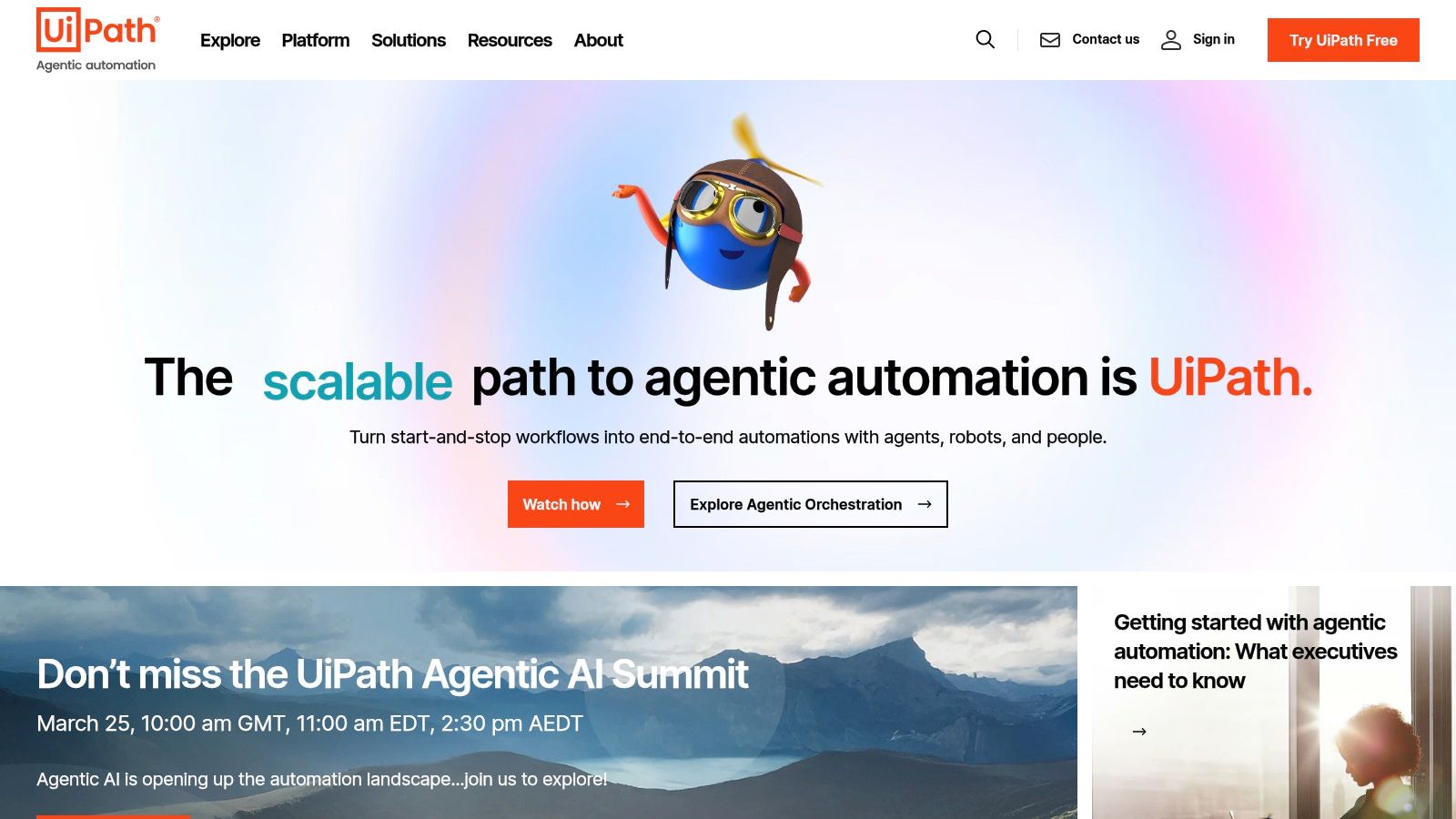
UiPath is a leading Robotic Process Automation (RPA) platform. It allows businesses to automate repetitive, rule-based tasks, freeing up employees for more strategic initiatives. UiPath combines RPA with AI, process mining, and analytics to create comprehensive automation solutions. This makes it a valuable tool for businesses of all sizes.
UiPath offers a wide range of applications for various professionals. Social media influencers and content creators can automate tasks like scheduling posts and collecting data. Small business owners can automate invoicing and customer service inquiries. Freelancers can use it for project management and client communication.
Key Features and Benefits
UiPath boasts an impressive feature set. Its AI-powered automation, including document understanding and computer vision, allows it to handle complex tasks involving unstructured data. Process mining and task mining features help identify automation opportunities within existing workflows.
For larger organizations, robust orchestration capabilities manage bot deployment at scale. This ensures smooth automation across the enterprise. A low-code automation builder, with its intuitive drag-and-drop interface, makes UiPath accessible to users without extensive coding experience. Integrated test automation further streamlines development.
Specific user benefits include:
- Social Media Influencers/Content Creators: Automate posting, engagement tracking, and reporting.
- Small Business Owners: Automate back-office tasks like invoicing and inventory management.
- Marketing Professionals: Automate lead generation, campaign management, and data analysis.
- Freelancers: Automate project management, time tracking, and client communications.
Pros and Cons of Using UiPath
UiPath offers several advantages:
- Comprehensive Platform: A robust, enterprise-grade automation platform with strong governance.
- AI Capabilities: Excels at handling unstructured data and documents.
- Extensive Ecosystem: A large partner ecosystem and a marketplace of pre-built components.
- Built-in Analytics: Advanced analytics and ROI tracking to measure automation impact.
However, there are also some drawbacks to consider:
- Cost: Can be expensive, requiring a significant investment.
- Complexity: Implementation can be complex, often requiring specialized expertise.
- Training: Advanced features may require specialized training or consultants.
- Resource Intensive: Running complex automations can be resource-intensive.
Pricing and Technical Requirements
UiPath offers various pricing plans. Contact their sales team for detailed pricing information. The platform can be deployed on-premises or in the cloud. Specific technical requirements depend on the deployment model and automation complexity.
Comparing UiPath to Other RPA Tools
While other RPA tools like Automation Anywhere and Blue Prism offer similar functionalities, UiPath stands out with its strong AI capabilities, user-friendly interface, and extensive partner ecosystem.
Tips for Successful Implementation
Start with small, well-defined automation projects. Invest in training to fully utilize the platform's capabilities. Consider partnering with a UiPath implementation partner for complex deployments. For additional automation resources, visit our site index.
Conclusion
UiPath’s comprehensive features and robust AI capabilities make it a powerful automation solution. Its ability to automate complex processes, handle unstructured data, and scale across the enterprise makes it a valuable asset for businesses seeking end-to-end automation.
Automation Anywhere
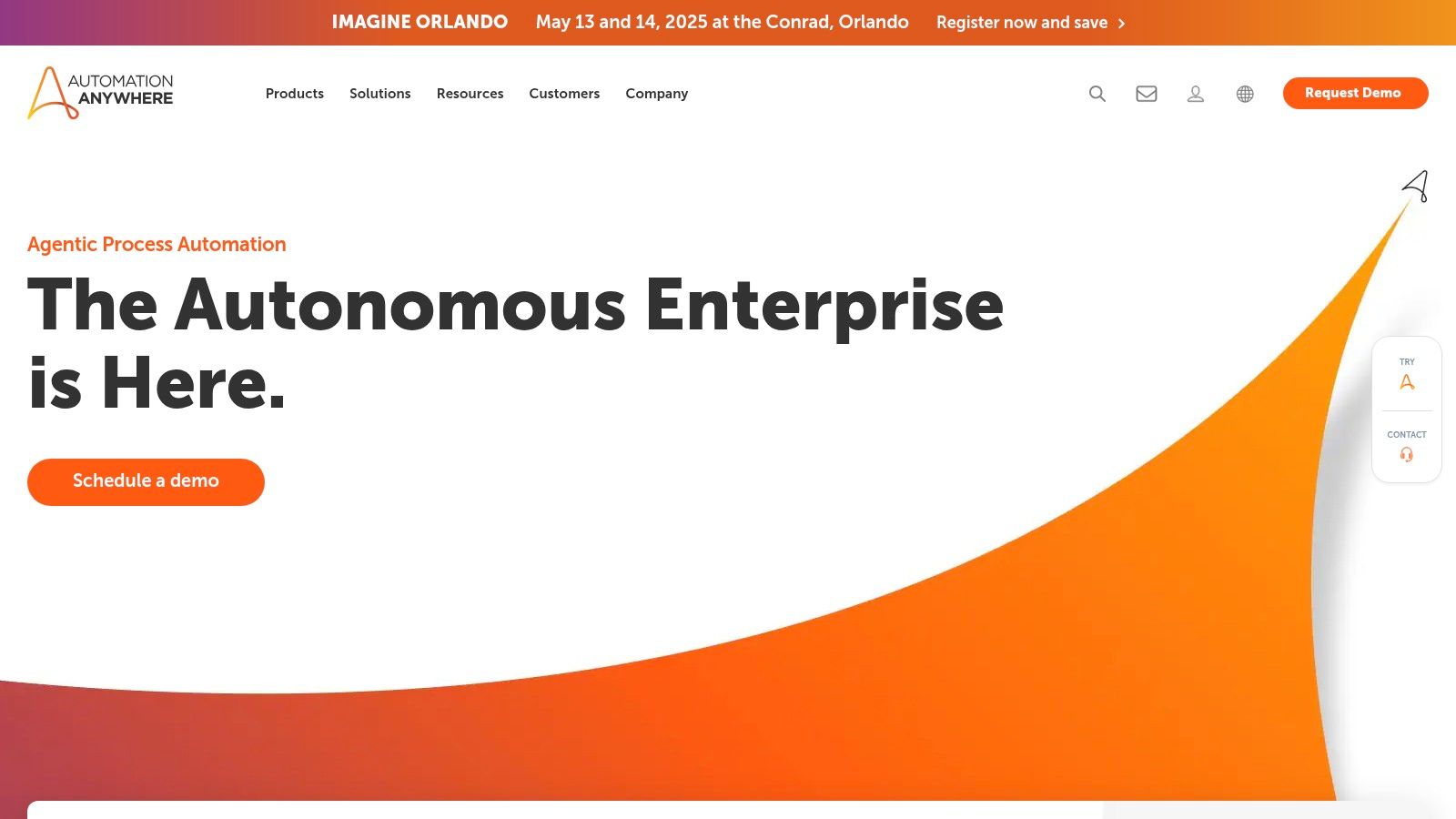
Automation Anywhere is a powerful, enterprise-grade Robotic Process Automation (RPA) solution. It’s ideal for larger organizations looking to scale their automation initiatives. While it might represent a larger investment for smaller businesses, its comprehensive features make it an attractive option for streamlining complex processes.
Automation Anywhere's core offering, Automation 360, allows businesses to deploy "digital workers," or software bots. These bots can handle numerous repetitive tasks, freeing up human employees. Think automating data entry, generating reports, or processing invoices. This allows your team to focus on strategic work requiring creativity and critical thinking.
Key Features and Benefits
Cloud-Native Architecture: Automation 360 is cloud-based, simplifying deployment, maintenance, and scalability. It eliminates the need for extensive on-premise infrastructure.
IQ Bot: This AI-powered document processing feature extracts data from various document formats, even unstructured data like emails and PDFs. This is a significant advantage for businesses handling large volumes of paperwork. Consider the possibilities for marketing professionals automating lead capture from web forms or social media.
Bot Insight: This feature provides real-time analytics and operational intelligence. You can monitor bot performance, identify bottlenecks, and optimize your automation strategies for continuous improvement and a demonstrable ROI.
Discovery Bot: This bot helps pinpoint automation opportunities within existing processes. This ensures you target the areas where RPA can deliver the biggest impact, which is especially valuable for businesses just starting their automation journey.
AARI (Automation Anywhere Robotic Interface): AARI enables smooth human-bot collaboration. Employees can easily interact with and manage bots from their desktops. This is especially useful for tasks requiring human oversight or approval.
Pros
- Robust Security: Includes granular role-based access controls.
- Simplified Management: Cloud-native architecture streamlines deployment and maintenance.
- Strong Governance: Comprehensive features for compliance, crucial for regulated industries.
- Powerful AI Capabilities: Handles complex processes with ease.
Cons
- Cost: Represents a significant investment, potentially challenging for smaller businesses.
- Technical Expertise: Advanced implementations may require specialized skills.
- Scaling Complexity: Large-scale deployments require careful planning and execution.
- Learning Curve: Some features may be more challenging to learn than those of competitors.
Pricing and Technical Requirements
Automation Anywhere offers tailored pricing based on individual business needs and deployment scale. Contact their sales team for a quote. Technical requirements depend on the deployment model (cloud or on-premise) and the specific features used. Visit their website for detailed information.
Implementation Tips
- Define Goals: Clearly outline your automation goals and identify key processes for RPA.
- Pilot Projects: Test your automation initiatives on a smaller scale before wider deployment.
- Training: Invest in training so your team can effectively manage your automation solutions.
- Professional Services: Consider using Automation Anywhere's professional services for complex implementations.
Comparison With Similar Tools
Automation Anywhere competes with other leading RPA platforms like UiPath and Blue Prism. All offer powerful automation, but Automation Anywhere emphasizes AI and its cloud-native design. UiPath is often considered more user-friendly, while Blue Prism is another enterprise-grade option focused on governance and security.
Website
https://www.automationanywhere.com/
Automation Anywhere is a robust tool for businesses embracing enterprise-grade automation. While it might not be suitable for every organization, its comprehensive features and powerful capabilities make it a compelling option for transforming operations and improving efficiency.
HubSpot Operations Hub
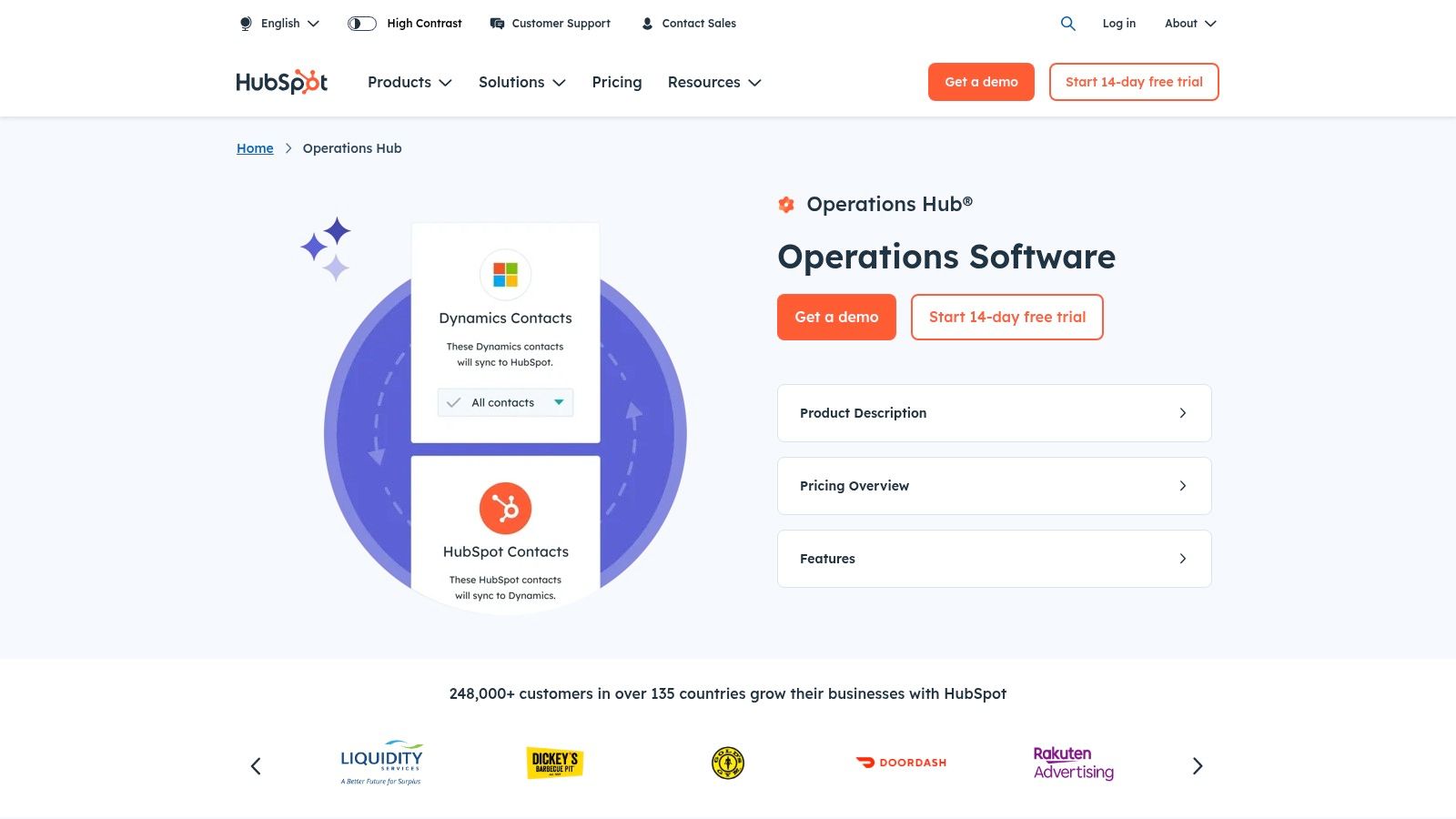
HubSpot Operations Hub is a powerful platform designed to streamline customer-facing operations. It’s especially useful for businesses already working within the HubSpot ecosystem. It integrates seamlessly with other HubSpot tools like Marketing Hub, Sales Hub, and Service Hub. This unified approach minimizes data silos and fosters better team collaboration.
Operations Hub offers a centralized solution for managing customer data and automating essential processes. This is ideal for social media influencers, small business owners, content creators, freelancers, and marketing professionals using HubSpot. Imagine capturing lead information from a Facebook ad campaign and syncing it directly to your CRM. Then, picture automatically launching a personalized email sequence. This is the power of Operations Hub in action.
Key Features of Operations Hub
Several key features empower these streamlined workflows:
Two-Way Data Sync: Integrate with hundreds of applications, ensuring consistent data across your entire tech stack, from your CRM to your accounting software. This feature is invaluable for businesses juggling multiple tools for marketing, sales, and customer service.
Programmable Automation: Visual workflows handle most automation needs. However, for more advanced requirements, custom code actions provide extra flexibility. This empowers you to automate virtually any process, including lead scoring, lead assignment, custom reporting, and specialized integrations.
Data Quality Tools: Maintain clean data with features like data cleansing and deduplication. These tools prevent issues like duplicate contacts, inaccurate reports, and inefficient marketing campaigns.
Custom Datasets & Reporting: Combine data from different sources to generate custom reports. These reports deliver a comprehensive overview of your business performance, providing valuable insights for data-driven decisions.
Pros and Cons of HubSpot Operations Hub
Pros:
- Seamless integration with the HubSpot platform
- Offers both no-code and code-based automation
- Focuses on customer-centric operations, uniting marketing, sales, and service
- Robust data quality tools for accuracy
Cons:
- Most beneficial for businesses already using HubSpot
- Advanced features require Professional or Enterprise subscriptions
- Custom coding requires technical expertise
- Less adaptable for non-customer-facing operations than some other platforms
Pricing and Technical Requirements
HubSpot Operations Hub offers tiered pricing based on features and contact limits. For detailed pricing information, visit the HubSpot website. The platform is cloud-based, minimizing technical requirements. However, custom code actions require knowledge of JavaScript and APIs. For further reading: Our guide on...
Implementation Tips
- Analyze your existing workflows and pinpoint areas for optimization.
- Prioritize integrating your core applications for effective data synchronization.
- Use pre-built workflows and templates to automate frequently used processes.
- Explore custom code options for more complex automation needs.
Comparison with Similar Tools
While platforms like Zapier or Make (formerly Integromat) offer wider integration options, HubSpot Operations Hub shines in its deep HubSpot ecosystem integration. This makes it an excellent choice for businesses already leveraging HubSpot's CRM and marketing tools.
HubSpot Operations Hub Website
https://www.hubspot.com/products/operations
Workato: Enterprise Automation Without Coding
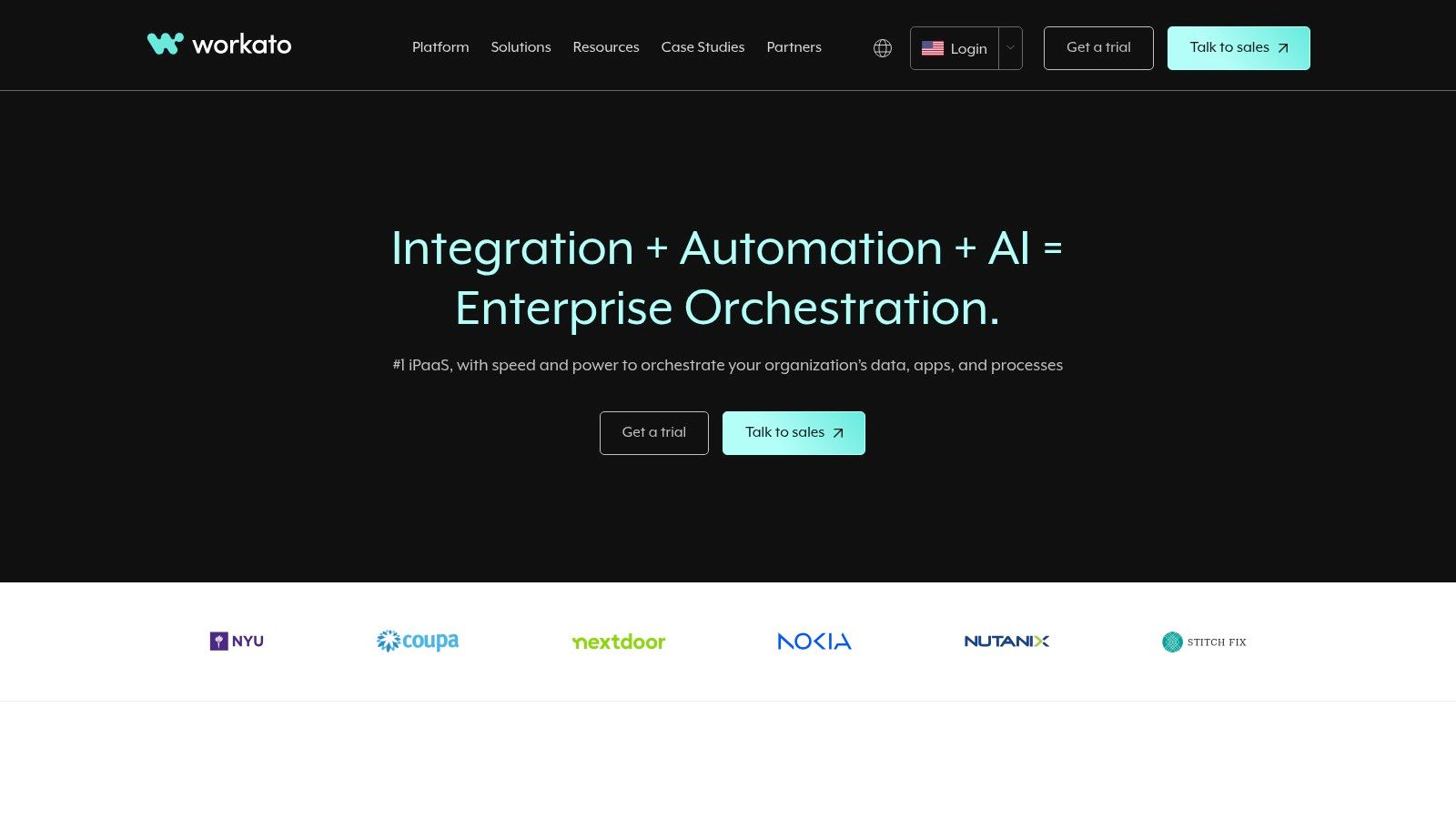
Workato is a powerful, user-friendly platform for enterprise automation. It goes beyond simple tasks by combining iPaaS (Integration Platform as a Service) capabilities with robust workflow automation. This allows businesses to connect apps, automate intricate processes, and transform data without extensive coding.
This is especially helpful for companies wanting to improve efficiency and streamline operations without needing a dedicated development team. For example, social media influencers can automate tasks like cross-posting and scheduling. Small businesses can automate order fulfillment and CRM processes.
Content creators can use Workato to distribute content and track performance. Freelancers can streamline client onboarding and invoicing. Marketing professionals can automate campaigns and lead nurturing.
Key Features and Benefits
Workato offers a range of features designed for efficient and secure automation:
AI-Powered Automation: Workato's AI suggests automation strategies and helps build "recipes," or pre-defined workflows, simplifying setup.
Enterprise-Grade Security: Features like role-based access control and encryption protect data and ensure compliance.
Community Recipes: Access thousands of pre-built automations in the Workato community library for quick implementation of common workflows.
OpsAdvisor: Monitor and manage your automations to ensure smooth and reliable operation in a production environment.
Low-Code API Management: Create and manage APIs with minimal coding, integrating seamlessly with custom applications and services.
Pros
All-in-One Platform: Workato combines iPaaS and workflow automation, eliminating the need for multiple tools.
Accessible and Powerful: It caters to both technical and business users with a user-friendly interface and advanced features for complex needs.
Collaboration Focused: Built-in features facilitate teamwork for collaborative automation building.
Handles Complex Integrations: Workato supports cloud-to-on-premises integration and other complex enterprise scenarios.
Cons
Higher Pricing: Workato's advanced features come at a premium price, typically geared toward enterprise budgets. Specific pricing isn't publicly available.
Complexity for Advanced Features: While generally user-friendly, some complex implementations might require specialized knowledge.
Learning Curve: Mastering all the advanced features requires time and effort.
Tiered Features: Some enterprise-grade features are limited to higher-priced tiers.
Implementation Tips
Begin with pre-built recipes from the community library for quick automation of common tasks.
Utilize the AI-powered recommendations to streamline the automation building process.
Define your automation goals and map your workflows before implementing.
For complex integrations or custom development, consider Workato's professional services.
Comparison With Similar Tools
While tools like Zapier or IFTTT provide basic automation, Workato offers enterprise-grade capabilities, advanced integrations, and a focus on complex workflows. It's a strong choice for those requiring a robust, scalable solution.
Website
Workato offers significant benefits for businesses of all sizes, particularly those with complex processes and integrations. The higher price point compared to simpler tools is often offset by increased efficiency, streamlined operations, and the capacity to handle complex automation.
7. Nintex: Streamline Your Business Processes

Nintex is a powerful process management and automation platform. It's perfect for businesses wanting to move beyond simple tasks and optimize entire workflows. Nintex provides a robust set of tools for everything from visually mapping processes to automating complex document workflows. It's especially helpful for organizations that rely heavily on documents, like contract approvals, invoice processing, or HR onboarding.
Imagine a new client signs up for your services. With Nintex, the entire process can be automated. Instead of manually routing contracts, generating invoices, and updating systems, Nintex handles it all. The contract is automatically sent for electronic signatures, the invoice is generated and sent to the client, and all systems are updated seamlessly.
Key Features and Benefits
Here's a breakdown of what Nintex offers:
Visual Process Mapping: Visually map your processes before automating them. This helps identify bottlenecks and areas for improvement, which is key to understanding and optimizing workflows.
No-Code Workflow Automation: Automate complex workflows with a simple drag-and-drop designer. This empowers business users to manage their own automation, even without coding experience.
Document Generation and Automation: Automate document creation, assembly, and routing. This eliminates manual errors and saves valuable time, especially for documents like contracts, proposals, and reports.
Electronic Signatures: Integrated electronic signatures streamline approvals and do away with printing and scanning.
Mobile-Friendly Forms and Data Capture: Create custom forms for data collection and integrate them into your workflows. Access these forms seamlessly, even on mobile devices.
Pros and Cons of Using Nintex
Like any platform, Nintex has its strengths and weaknesses:
Pros:
End-to-End Solution: Nintex offers a complete platform, from process mapping to automation, creating a smooth and integrated experience.
Document-Centric Powerhouse: Nintex excels at managing document-heavy processes, making it a great fit for businesses that rely on documents.
Seamless Microsoft Integration: Nintex integrates smoothly with SharePoint and Office 365, maximizing existing investments.
Robust Forms for Complex Data: Collect and manage even the most complex data with customizable forms.
Cons:
Pricing: Nintex's licensing model can be complex and potentially expensive as you scale. Contact Nintex directly for specific pricing information.
Complexity: Nintex might be overkill for very basic automation tasks.
Value Realization: You'll get the most out of Nintex by using multiple features of the platform.
Customization: Advanced customizations might require some technical expertise.
Implementation Tips
Here are a few tips for getting started with Nintex:
Start Small: Begin by automating a single process to get familiar with the platform.
Utilize Nintex's Resources: Take advantage of Nintex's training materials and community forums.
Consider Consulting: For complex implementations, consider engaging a Nintex partner.
Comparison with Other Tools
While tools like Kissflow and ProcessMaker offer similar features, Nintex’s strong Microsoft integration and robust document automation make it a top choice for Microsoft-centric businesses and those with complex document workflows.
Final Thoughts on Nintex
Nintex helps businesses go beyond basic task automation to optimize entire processes. By streamlining workflows and automating key tasks, Nintex empowers businesses to improve efficiency, reduce errors, and focus on growth. Visit the Nintex website for more information.
Airtable: Your All-In-One Workspace
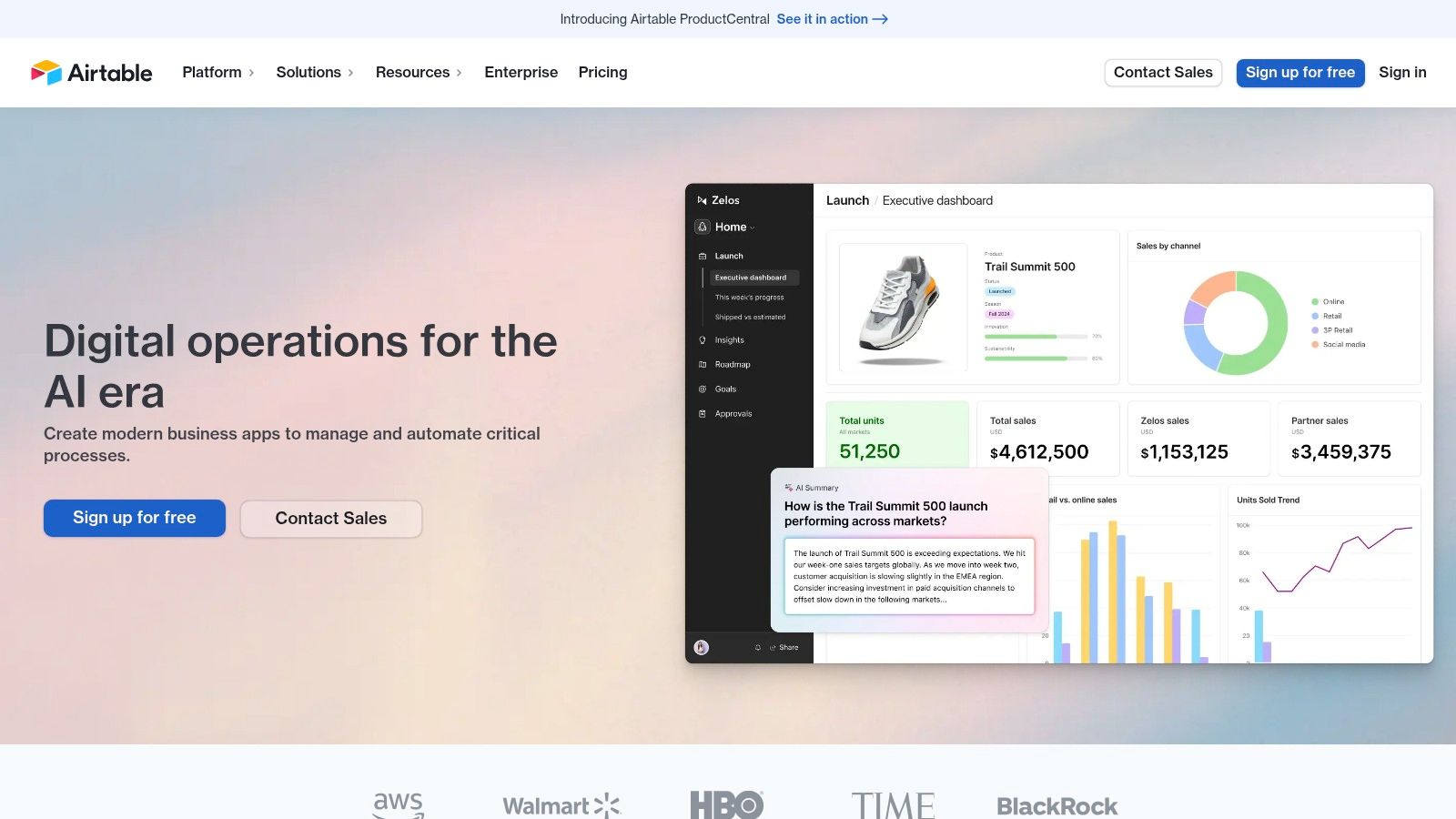
Airtable is a powerful, user-friendly platform that bridges the gap between spreadsheets and databases. It’s ideal for social media influencers, small business owners, content creators, freelancers, and marketing professionals who need a central hub for managing projects, team collaboration, and automating repetitive tasks. Think of it as a spreadsheet with superpowers.
Imagine managing your content calendar, tracking campaign performance, organizing client information, and planning product launches, all within a single customizable platform. This is the power of Airtable. Its flexible structure allows you to create custom databases tailored to your needs, with over 15 field types including attachments, barcodes, and linked records.
Key Features and Benefits
Custom Databases: Build databases to organize anything from blog posts and social media campaigns to sales leads. The diverse field types ensure you can capture all necessary information.
Visual Automations: Airtable's Automation builder lets you create workflows triggered by specific events within your database. Automatically assign tasks when a new project is added or send notification emails when deadlines approach.
Multiple Views: View your data in various formats like grid, calendar, Kanban, Gantt, form, and gallery, allowing you to visualize information in the way that best suits your workflow.
Scripting for Advanced Automation: For those familiar with JavaScript, Airtable offers scripting capabilities for complex and customized automations.
Interfaces & Dashboards: Create custom interfaces and dashboards to visualize key metrics, track progress, and gain actionable insights.
Practical Use Cases
Social Media Influencers: Manage brand collaborations, track content performance, and schedule posts.
Small Business Owners: Organize customer relationships, track inventory, and manage projects.
Content Creators: Plan content calendars, track article ideas, and manage editorial workflows.
Freelancers: Track client projects, manage invoices, and organize tasks.
Marketing Professionals: Manage campaigns, track leads, and analyze performance data.
Pricing and Availability
Airtable offers a free plan with limited features. Paid plans with increasing features and storage start from $10 per user/month. Advanced features like SSO and unlimited workspaces are available on the Enterprise plan (contact sales for pricing). Airtable is cloud-based and accessible through any web browser, with mobile apps for iOS and Android devices.
Comparing Airtable
While similar to tools like Notion, Coda, and Monday.com, Airtable’s database-centric approach and highly customizable interface set it apart. While its built-in automation might be less extensive than dedicated automation platforms like Zapier or Make, its flexibility and ease of use make it an excellent option for many businesses.
Implementation Tips
Start with a Template: Explore Airtable’s extensive template gallery.
Focus on One Database: Start with a single database and expand as needed.
Experiment with Views: Use different view options to visualize your data effectively.
Explore Automations: Begin with simple automations and gradually build complexity.
Pros and Cons
Pros:
- Combines database, project management, and automation in one platform.
- Highly customizable.
- Intuitive interface.
- Extensive template gallery.
Cons:
- Limited automation compared to dedicated platforms.
- Advanced features require higher-priced plans.
- Can become complex as databases grow.
- Some enterprise features require the Enterprise plan.
Website: Airtable
Process Street: Streamline Your Operations With Superpowered Checklists
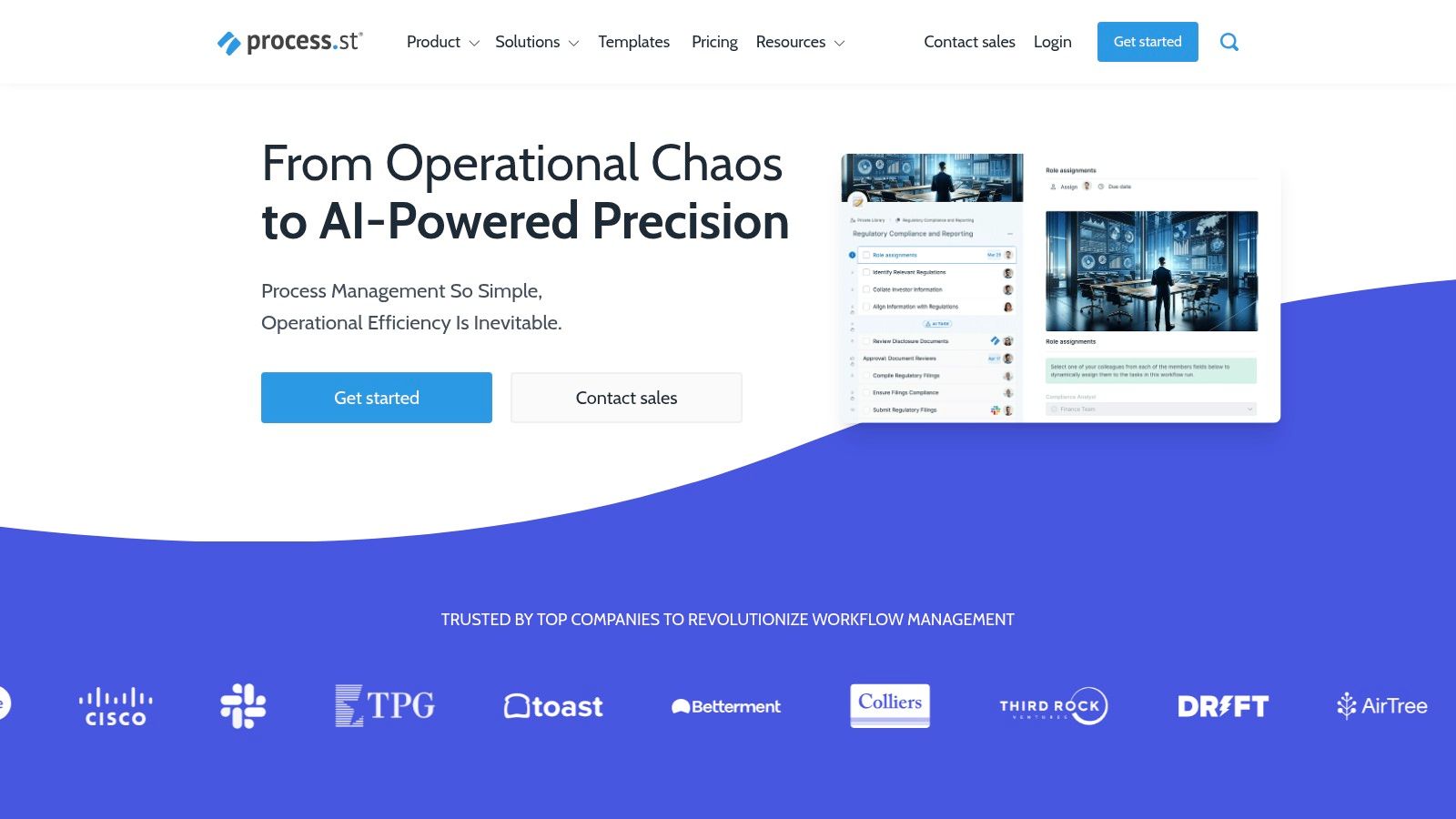
Process Street stands out as a robust solution for managing recurring workflows and ensuring consistent execution of Standard Operating Procedures (SOPs). Whether you're a social media influencer, a small business owner, a freelancer, or a marketing professional, Process Street can bring order and efficiency to your daily operations.
Instead of juggling emails, spreadsheets, and sticky notes, Process Street offers a centralized platform. This platform allows you to document, track, and optimize your most important processes. Think of it as a system of superpowered checklists guiding your team through each step, ensuring nothing is missed.
Practical Applications
Process Street offers solutions for a variety of business needs:
- Content Calendar Management: Streamline content creation, approvals, and publishing.
- Client Onboarding: Create a consistent and professional onboarding experience.
- Project Management: Manage tasks, deadlines, and deliverables, keeping everyone aligned.
- Social Media Management: Schedule posts, track engagement, and manage campaigns.
- Employee Onboarding: Standardize the onboarding process, ensuring access to key information.
Key Features and Benefits
Process Street offers a range of features designed to improve workflow management:
- Visual Workflow Builder: Create documented procedures with an easy-to-use drag-and-drop interface.
- Conditional Logic: Design dynamic checklists that adapt based on user input.
- Form Fields: Collect data directly within the workflow, streamlining data entry.
- Integrations: Connect with over 3000 apps via Zapier and native integrations.
- Permissions and Approvals: Control access and implement approval workflows to maintain quality and compliance.
- Analytics: Track workflow completion rates, identify bottlenecks, and optimize processes.
Pros
- Excellent for standardizing and enforcing operational procedures.
- User-friendly interface.
- Strong analytics for tracking progress.
- Combines documentation and execution in one platform.
Cons
- More focused on human-driven processes than full automation.
- Limited native integrations compared to some competitors.
- Advanced features require a paid plan.
- Best suited for procedure-based work.
Pricing and Technical Requirements
Process Street has a free plan for basic usage, with paid plans starting at $25/user/month. For the most current pricing, visit their website. As a cloud-based platform, Process Street is accessible via any modern web browser.
Implementation Tips
Here are a few tips for getting started with Process Street:
- Begin with a simple process to learn the platform.
- Use templates to create workflows quickly.
- Connect with other tools through integrations.
- Regularly review and update your processes.
Comparison With Similar Tools
While tools like Monday.com and Asana offer workflow management, Process Street focuses on SOP documentation and human-in-the-loop processes. This focus makes it ideal for teams prioritizing consistency and compliance.
Website: Process Street
N8n: Open-Source Automation For Everyone
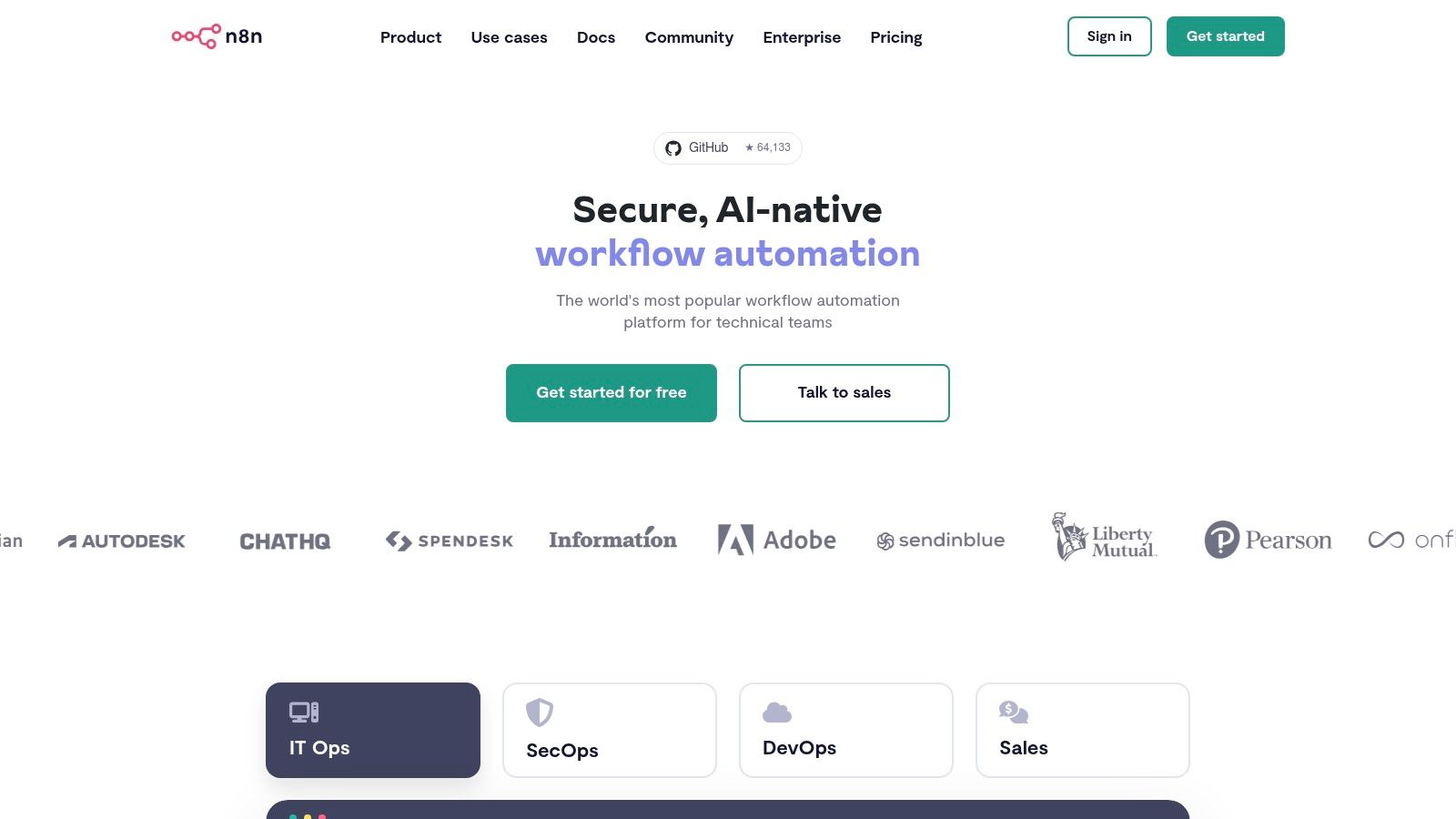
N8n is a leading open-source workflow automation tool, offering users significant control and flexibility. Unlike cloud-based alternatives that often limit usage with node restrictions, n8n's fair-code license allows for unlimited automation, even in the free, self-hosted version. This makes it a particularly attractive option for technically-minded individuals such as social media influencers, small business owners, content creators, freelancers, and marketing professionals seeking to optimize their workflows efficiently.
Imagine automating your entire social media content process. You could pull articles from RSS feeds, generate social media posts with relevant hashtags, schedule them across various platforms, and even analyze performance metrics, all without relying on multiple, expensive SaaS tools. N8n makes this a reality.
With over 250 pre-built nodes, n8n connects to a wide range of applications and services, including popular social media platforms, CRM systems, email marketing tools, and more. For less common services, webhook nodes enable custom integrations and trigger workflows via API endpoints.
Advanced Customization With N8n
For the technically proficient, the ability to inject custom JavaScript code using Function nodes provides even greater customization. This allows for data transformation, application of complex logic, and creation of highly specific automation solutions.
Practical Applications of N8n
- Social Media Management: Automate posting, scheduling, and analytics.
- Content Creation & Distribution: Automate content aggregation, formatting, and distribution.
- Lead Generation & Nurturing: Automate lead capture, qualification, and follow-up.
- Marketing Automation: Automate email campaigns, A/B testing, and reporting.
- E-commerce Automation: Automate order fulfillment, inventory, and customer support.
Pricing and Technical Requirements
N8n offers both cloud-hosted and self-hosted options. The cloud version has tiered pricing plans based on usage and features. The self-hosted version is free under the fair-code license but requires technical expertise for installation and maintenance on your own server or cloud infrastructure. Familiarity with Docker and command-line interfaces is helpful.
Pros and Cons of Using N8n
Pros:
- Complete Data Control: Self-hosting ensures data privacy.
- No Node Limits: Automate complex workflows without restrictions.
- Strong Technical Capabilities: Ideal for developers and power users.
- Active Community: Benefit from community support and development.
Cons:
- Steeper Learning Curve: Requires some technical knowledge.
- UI Could Be More Polished: The interface is less user-friendly than some paid alternatives.
- Self-Hosting Requires Technical Setup: Not ideal for non-technical users.
- Smaller Pre-built Template Marketplace: Fewer ready-made templates.
Getting Started With N8n
Begin with a simple workflow to familiarize yourself with the interface and node functionality. The n8n community forum is a valuable resource for assistance and inspiration.
Conclusion: Is N8n Right for You?
N8n may not be as plug-and-play as some commercial automation tools, but its power, flexibility, and open-source nature make it a strong choice for users prioritizing control, customization, and data privacy. If you’re comfortable with some technical setup, n8n can unlock significant automation potential for your business or projects. Visit the n8n website.
Top 10 Business Automation Tools Comparison
| Platform | Key Features ★ | UX & Value 💰 | Target Audience 👥 | Unique Selling Points ✨ |
|---|---|---|---|---|
| Zapier | 5,000+ app integrations, multi-step Zaps | Easy interface, free tier, high template value | Businesses (marketing, sales) | No-code workflow automation |
| Microsoft Power Automate | MS365 integration, AI Builder, RPA capabilities | Seamless, secure, mobile management | Microsoft-centric firms | Cloud & desktop flows |
| UiPath | Enterprise RPA, AI-powered, process mining | Robust, analytics-driven, pro-level automation | Large enterprises, professionals | Complete orchestration and governance |
| Automation Anywhere | Cloud-native, IQ Bot, real-time analytics | Secure, scalable, enterprise-ready | Large organizations | Human-bot collaboration (AARI) |
| HubSpot Operations Hub | Two-way sync, programmable automation, data quality tools | Unified CRM experience, smooth operation | Customer-facing teams | Seamless HubSpot ecosystem |
| Workato | Integration + workflow automation, low-code API management | Powerful yet accessible | IT teams & business users | Collaboration for complex integrations |
| Nintex | Process mapping, document automation, forms | Intuitive for document-centric flows | Microsoft-centric & process teams | Deep SharePoint integration |
| Airtable | Custom databases, built-in automations, versatile views | Visual, intuitive, flexible | Creative, marketing, ops teams | All-in-one database & automation |
| Process Street | Visual SOP builder, checklists, dynamic forms | User-friendly, focused on operational tracking | Teams needing SOPs & compliance | Integrated process documentation & execution |
| n8n | Open-source, self-hosted, 250+ pre-built nodes | Powerful with a steeper learning curve | Developers & technical users | Unlimited nodes & complete data control |
Choosing The Right Business Automation Solution
Finding the perfect business automation solution can be daunting, given the multitude of options. Whether you're a social media influencer managing various platforms, a small business owner streamlining operations, a content creator with a complex workflow, a freelancer optimizing client interactions, or a marketing professional automating campaigns, the right tool depends entirely on your specific needs.
This article explored various automation platforms, from straightforward workflow automation tools like Zapier and Microsoft Power Automate to robust Robotic Process Automation (RPA) solutions like UiPath and Automation Anywhere. We also looked at specialized platforms such as HubSpot Operations Hub for marketing and sales automation, Workato for enterprise-grade integration, Nintex for process management, and Airtable for database-centric workflows. Simpler options like Process Street and n8n offer a more accessible entry point to process documentation and automation, respectively.
Key Considerations For Choosing a Platform
When deciding between these powerful tools, consider the following:
- Workflow Complexity: Are you automating simple tasks or complex, multi-step processes?
- Application Integration: Which apps need connecting? Carefully check compatibility and available integrations.
- Technical Expertise: Some tools require coding, while others offer no-code/low-code interfaces. Select a solution that matches your team's skills.
- Scalability: As your business expands, your automation requirements will change. Ensure your chosen solution can grow with you.
- Budget and Resources: Evaluate the pricing model, implementation costs, and ongoing maintenance expenses.
Getting Started With Business Automation
Begin by identifying a single, repetitive task to automate. Start small, assess the impact, and gradually broaden your automation efforts. Prioritize user training and ensure smooth integration with your current systems.
Managing and optimizing how your audience accesses your content is crucial for a successful online presence. Automating internal workflows is important, but streamlining your online presence is equally vital.
Streamlining Your Online Presence With Linkero
Tired of managing multiple links and platforms? Linkero provides a powerful and user-friendly way to consolidate your online presence into a single, customizable link-in-bio page. Ideal for social media influencers, content creators, small business owners, and anyone wanting to improve online visibility, Linkero offers a seamless experience. With no coding or design skills needed, you can create a professional, branded link-in-bio page in three easy steps: add your content, customize the style, and analyze performance with built-in analytics. Enhance your online presence and connect with your audience more effectively with Linkero. Get started with Linkero today!


